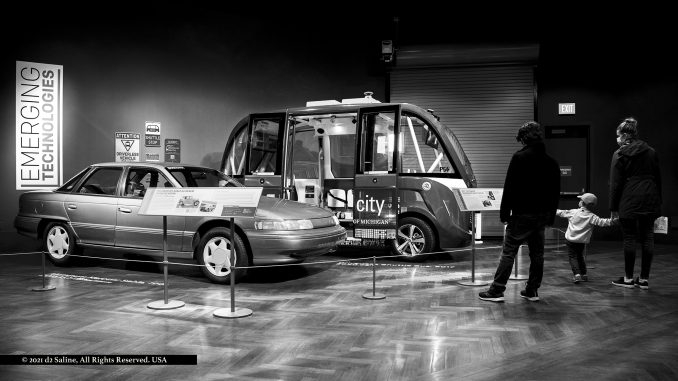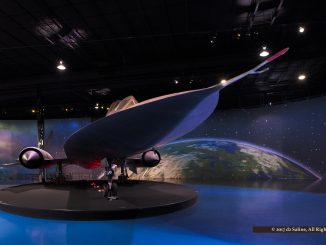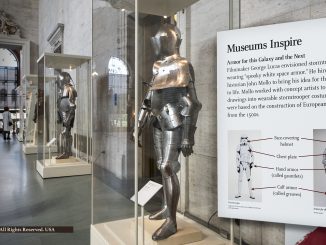
During the summer of 2018, The University of Michigan “Mcity” collaborative launched a “Driverless Shuttle research project” on North Campus. Its stated objective “was to learn more about the challenges and opportunities presented by this type of mobility service and how people interact with it.” [1-3]
Two automous vehicles were aquired by Mcity for this project, both sourced through NAVYA in France. After the eighteen-month public road deployment concluded in December of 2019, volumes of data had been accumulated for analysis, and the “Autonom” shuttles were decommissioned. [4-6]
And on October 15, 2020, The Henry Ford Museum of American Innovation announced that it had acquired one of them for its collection. [7]
Today that self-driving vehicle went on display for the first time as part of a special exhibit titled “Collecting Mobility: New Objects, New Stories” in the General Motors Gallery at The Henry Ford. It is a cornerstone among thirty pieces selected to answer the question “What makes an object museum-worth?” [8,9]
At first glance, visitors will note bold summary labeling on the floor before each display. A top line briefly labels the object and its year. Below that, three “accession numbers” note acquisition year, the accession of which it was a part that year, and its sequence within that accession; acknowledgment of source typically follows.
To put this into perspective, The Henry Ford Museum of American Innovation currently numbers is collection at “more than 26 million artifacts, from everyday items to technological breakthroughs.” Without a meaningful numbering system, kept rigorously current, little could be accessed for meaningful display when called for.
However, the raison d’être for Collecting Mobility was established through the powerful establishment panels set before each display, in parallel structure. A full half of each provided important category history along with artifact particulars. Juxtaposed against this, the other half called out “Tech & Specs,” and addressed the question “Why Did We Take it?”
For example, the 1977 Ford Mustang II just inside the gallery opening and orientation area, positioned that vehicle as a return to its compact-car roots. “Though not especially loved by car collectors or Mustang fans today, the Mustang II sold well in its time — more than a million units — and kept the brand alive during a turbulent decade for America’s automotive industry.
Why Did We Take It?
‘The collecting plan includes a car from what automotive journalists and enthusiasts call the “Malaise Era,” circa 1973-1983 — when less-than-stellar American automobiles struggled with new emissions and safety regulations, inconsistent quality control, and ever-improving foreign competition. This is a rare opportunity to acquire a well-preserved, well-documented car that tells an important story about the American auto industry at a challenging time.’
From the accession justification
This was undoubtedly a courageous choice of an item to set the stage for what all that was to come after it within the closed gallery beyond. An easily more dramatic, engaging option would have been the “Ford Transit Van, Modified for Use asa COVID-19 Mobile Testing Facility, 2020,” fully around the corner. [10]
But that is not the purpose of Collecting Mobility. Visitors will be best served to expect an immersive experience both far greater in reach and more cerebrial, even deceptively pedestrian, in presentation. Taken at the slower, more disciplined pace it deserves, this exhibition is another key to maximizing the whole of what The Henry Ford and Greenfield Village have to offer.
And beyond that, maybe even an offer of valuable insights to all sorts of other formal collections and museums as well.
In the spring of 2018, NAVYA offered rides on its autonomous vehicle, which followed a large course within a fenced area within Cobo Center during the SAE WCX18 trade show. During the Mackinac Policy Conference a year later, Michigan Governor Gretchen Whitmer announced “The NAIAS 2020 Mobility Challenge,” anticipating “that responses might include approaches to autonomous vehicle transportation offerings in and around the now summertime 2020 Cobo Center event. [11,12]
She also suggested that some form of transport for travelers between DTW and downtown Detroit would be appealing.
Today, the “2017 ‘Autonom’ Driverless Shuttle Bus” is arguably the least apparently emphasized artifact within the Collecting Mobility space. Its own accession justification paragraph leads with emphasis on “the 2016 General Motors First-Generation Self-Driving Test Vehicle” as rationale. [13-15]
It goes to show that, even in an exhibition dedicated to the meta-story of preserving history, =history itself= is still being written. Focus often changes; timely is seldom synonymous with timeless.
Collecting Mobility: New Objects, New Stories is scheduled to run today through January 2, 2022 at The Henry Ford, open currently with museum hours. Access to this limited-engagement gallery is included in the price of admission, and free to members. [16]
See Saline Journal Flickr feed for additional photographs of this exhibition. [17]
References
- Mcity (home page).
- Mcity Driverless Shuttle: What We Learned About Consumer Acceptance of Automated Vehicles, Sarah Cicotte, Huei Peng PhD, and Kristin Kolodge (October 2020) University of Michigan.
- “What Cities Need to Know about Consumer Acceptance of Autonomous Vehicles” Dell Deaton (March 30, 2018) Saline Journal.
- NAVYA (home page).
- “NAVYA Premiered Its Self-Driving Shuttle at NAIAS Earlier This Year” Dell Deaton (February 5, 2018) Saline Journal.
- “Navya launches the first fully autonomous level 4 operation on a closed site” Navya (July 15, 2020) YouTube.
- “The Henry Ford Acquires Navya Autonom Shuttle Used by Mcity” (October 24, 2020) Cision PRWeb.
- “Collecting Mobility: New Objects, New Stories” (October 23, 2021 – January 2, 2022) The Henry Ford.
- “General Motors Contributes $5 Million to The Henry Ford” (October 17, 2017) GM Corporate Newsroom.
- “Collecting Mobility: Insights from Ford Motor Company” (October 22, 2021) The Henry Ford.
- “Ready or Not, Autonomous Vehicles Rolled Further Ahead This Week Toward Inevitability with Mobility for All” Dell Deaton (May 31, 2018) Saline Journal.
- “Mackinac Policy Conference 2019, Part 3: A renewed, competitive passion for multimodal transportation” Dell Deaton (May 31, 2019) Saline Journal.
- “Collecting Mobility: Insights from University of Michigan” (October 15, 2021) The Henry Ford.
- “Our First Autonomous Car: The 2016 General Motors Self-Driving Test Vehicle” (March 11, 2019) The Henry Ford.
- “The Henry Ford acquires GM’s first self-driving test vehicle” (March 12, 2019) WXYZ.
- “Henry Ford Museum of American Innovation” The Henry Ford.
- Dell Deaton (Flickr Photostream).



